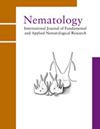Host plant status and damage threshold of spinach (Spinacia oleracea) for the temperate root-knot nematode Meloidogyne chitwoodi
IF 1.2
4区 生物学
Q2 ZOOLOGY
引用次数: 0
Abstract
Problems with plant-parasitic nematodes remain a major challenge in most field vegetable crops worldwide. In agricultural fields in Belgium, these problems have increased in recent years. A major problem is the quarantine root-knot nematode Meloidogyne chitwoodi. The host plant status of the most commonly grown cultivars of spinach (Spinacia oleracea) and the damage threshold for M. chitwoodi were determined in a climate-controlled glasshouse and in a naturally infested field. The yield data with the final population densities were fitted to Seinhorst’s yield and population dynamic models, respectively. The damage threshold values (T) for the relative fresh weight yield were 0.14, 1.08, 11.53 J2 (100 cm3 soil)−1, minimum yield (m) of 0.84, 0.64, 0.52 and maximum yield () of 12.51, 12.44 and 9.60 for ‘Gnu’, ‘Meerkat’ and ‘Whale’ spinach cultivars, respectively. The maximum multiplication rates (a) were 3.81, 2.38 and 2.72, whilst the maximum population densities (M) were 563, 916, and 922 J2 (100 cm3 soil)−1 for ‘Gnu’, ‘Meerkat’ and ‘Whale’, respectively. Meloidogyne chitwoodi had an impact on the spinach yield. The higher the nematode density the lower the yield and vice versa. The tested cultivars were all hosts for M. chitwoodi but differences between cultivars occurred. ‘Kolibri’ and ‘Rhino’ were tested as the least sensitive cultivars for M. chitwoodi during the host screening test and bring opportunities for resistance breeding. This is the first report of spinach as a host for M. chitwoodi.菠菜(Spinacia oleracea)对温带根结线虫Meloidogyne chitwoodi的寄主植物状况及危害阈值
植物寄生线虫的问题仍然是世界上大多数大田蔬菜作物面临的主要挑战。在比利时的农业领域,这些问题近年来有所增加。一个主要问题是检疫根结线虫。在气候控制的温室和自然侵染的田间,测定了最常见的菠菜品种(菠菜)的寄主植物状况和chitwoodi的危害阈值。将最终种群密度的产量数据分别拟合到Seinhorst产量和种群动态模型中。“Gnu”、“Meerkat”和“Whale”菠菜品种相对鲜重产量的危害阈值(T)分别为0.14、1.08、11.53 J2 (100 cm3土壤)−1,最小产量(m)分别为0.84、0.64、0.52,最大产量()分别为12.51、12.44和9.60。“Gnu”、“Meerkat”和“Whale”的最大繁殖率(a)分别为3.81、2.38和2.72,最大种群密度(M)分别为563、916和922 J2 (100 cm3土壤)−1。七木霉对菠菜产量有影响。线虫密度越高,产量越低,反之亦然。供试品种均为赤霉病寄主,但品种间存在差异。在寄主筛选试验中,‘Kolibri’和‘Rhino’被鉴定为对chitwoodi病菌最不敏感的品种,为抗性育种带来了机会。这是关于菠菜作为chitwoodi病菌寄主的首次报道。
本文章由计算机程序翻译,如有差异,请以英文原文为准。
求助全文
约1分钟内获得全文
求助全文
来源期刊

Nematology
生物-动物学
CiteScore
2.60
自引率
33.30%
发文量
67
审稿时长
3 months
期刊介绍:
Nematology is an international journal for the publication of all aspects of nematological research (with the exception of vertebrate parasitology), from molecular biology to field studies. Papers on nematode parasites of arthropods, and on soil free-living nematodes, and on interactions of these and other organisms, are particularly welcome. Research on fresh water and marine nematodes is also considered when the observations are of more general interest.
Nematology publishes full research papers, short communications, Forum articles (which permit an author to express a view on current or fundamental subjects), perspectives on nematology, and reviews of books and other media.
 求助内容:
求助内容: 应助结果提醒方式:
应助结果提醒方式:


